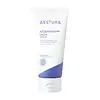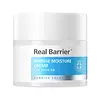What's inside
What's inside
 Key Ingredients
Key Ingredients

 Benefits
Benefits

 Concerns
Concerns

 Ingredients Side-by-side
Ingredients Side-by-side

Water
Skin ConditioningButylene Glycol
HumectantGlycerin
HumectantButylene Glycol Dicaprylate/Dicaprate
EmollientCetyl Ethylhexanoate
EmollientSqualane
EmollientPentaerythrityl Tetraisostearate
EmollientDicaprylyl Carbonate
EmollientBehenyl Alcohol
EmollientDimethicone
EmollientHydroxypropyl Bispalmitamide Mea
EmollientStearic Acid
CleansingBetaine
HumectantMannitol
HumectantC14-22 Alcohols
Emulsion StabilisingPalmitic Acid
EmollientHydroxypropyl Bislauramide Mea
EmollientArachidyl Alcohol
EmollientCholesterol
EmollientPolyacrylate-13
C12-20 Alkyl Glucoside
EmulsifyingAllantoin
Skin ConditioningArachidyl Glucoside
EmulsifyingNiacinamide
SmoothingCeramide NP
Skin ConditioningGlyceryl Caprylate
EmollientEthylhexylglycerin
Skin ConditioningHydrogenated Polyisobutene
EmollientCarbomer
Emulsion StabilisingTromethamine
BufferingDimethiconol
EmollientPolyglyceryl-10 Laurate
Skin ConditioningHydrogenated Lecithin
EmulsifyingEthylhexyl Palmitate
EmollientAcrylates/Ammonium Methacrylate Copolymer
Sorbitan Isostearate
EmulsifyingSilica
AbrasivePhytosphingosine
Skin ConditioningSphingolipids
EmollientArachidic Acid
CleansingTocopherol
AntioxidantOleic Acid
EmollientWater, Butylene Glycol, Glycerin, Butylene Glycol Dicaprylate/Dicaprate, Cetyl Ethylhexanoate, Squalane, Pentaerythrityl Tetraisostearate, Dicaprylyl Carbonate, Behenyl Alcohol, Dimethicone, Hydroxypropyl Bispalmitamide Mea, Stearic Acid, Betaine, Mannitol, C14-22 Alcohols, Palmitic Acid, Hydroxypropyl Bislauramide Mea, Arachidyl Alcohol, Cholesterol, Polyacrylate-13, C12-20 Alkyl Glucoside, Allantoin, Arachidyl Glucoside, Niacinamide, Ceramide NP, Glyceryl Caprylate, Ethylhexylglycerin, Hydrogenated Polyisobutene, Carbomer, Tromethamine, Dimethiconol, Polyglyceryl-10 Laurate, Hydrogenated Lecithin, Ethylhexyl Palmitate, Acrylates/Ammonium Methacrylate Copolymer, Sorbitan Isostearate, Silica, Phytosphingosine, Sphingolipids, Arachidic Acid, Tocopherol, Oleic Acid
Water
Skin ConditioningMethylpropanediol
SolventPanthenol
Skin ConditioningCyclopentasiloxane
EmollientCaprylic/Capric Triglyceride
MaskingMyristoyl/Palmitoyl Oxostearamide/Arachamide Mea
Skin ConditioningSorbitan Stearate
EmulsifyingHydroxyethyl Urea
HumectantSqualane
EmollientCetearyl Alcohol
EmollientGlyceryl Stearate Citrate
Emollient1,2-Hexanediol
Skin ConditioningGlycerin
HumectantCanola Oil
EmollientSodium Acrylic Acid/Ma Copolymer
Caprylyl Glycol
EmollientArginine
MaskingCarbomer
Emulsion StabilisingAllantoin
Skin ConditioningTocopherol
AntioxidantButylene Glycol
HumectantXanthan Gum
EmulsifyingViscum Album Fruit Extract
SoothingDihydroxyisopropyl Palmoylpalmamide
HumectantPhytosterols
Skin ConditioningRicinus Communis Seed Oil
MaskingEctoin
Skin ConditioningPropanediol
SolventSodium Hyaluronate
HumectantSodium Hyaluronate Crosspolymer
HumectantHydrolyzed Glycosaminoglycans
HumectantJuniperus Virginiana Oil
MaskingRosmarinus Officinalis Leaf Oil
MaskingCeramide NP
Skin ConditioningMadecassoside
AntioxidantCopaifera Officinalis Resin
MaskingHydrolyzed Hyaluronic Acid
HumectantBenzyl Glycol
SolventEucalyptus Globulus Leaf Oil
PerfumingHydroxypropyltrimonium Hyaluronate
Pogostemon Cablin Leaf Oil
MaskingLinoleic Acid
CleansingBeta-Glucan
Skin ConditioningSodium Acetylated Hyaluronate
HumectantViola Odorata Leaf Extract
MaskingLavandula Angustifolia Oil
MaskingCananga Odorata Flower Oil
MaskingArtemisia Vulgaris Oil
PerfumingAnthemis Nobilis Flower Oil
MaskingEthylhexylglycerin
Skin ConditioningJasminum Officinale Oil
MaskingFerula Galbaniflua Resin Oil
AntimicrobialChamomilla Recutita Flower Oil
MaskingHyaluronic Acid
HumectantRaspberry Ketone
MaskingWater, Methylpropanediol, Panthenol, Cyclopentasiloxane, Caprylic/Capric Triglyceride, Myristoyl/Palmitoyl Oxostearamide/Arachamide Mea, Sorbitan Stearate, Hydroxyethyl Urea, Squalane, Cetearyl Alcohol, Glyceryl Stearate Citrate, 1,2-Hexanediol, Glycerin, Canola Oil, Sodium Acrylic Acid/Ma Copolymer, Caprylyl Glycol, Arginine, Carbomer, Allantoin, Tocopherol, Butylene Glycol, Xanthan Gum, Viscum Album Fruit Extract, Dihydroxyisopropyl Palmoylpalmamide, Phytosterols, Ricinus Communis Seed Oil, Ectoin, Propanediol, Sodium Hyaluronate, Sodium Hyaluronate Crosspolymer, Hydrolyzed Glycosaminoglycans, Juniperus Virginiana Oil, Rosmarinus Officinalis Leaf Oil, Ceramide NP, Madecassoside, Copaifera Officinalis Resin, Hydrolyzed Hyaluronic Acid, Benzyl Glycol, Eucalyptus Globulus Leaf Oil, Hydroxypropyltrimonium Hyaluronate, Pogostemon Cablin Leaf Oil, Linoleic Acid, Beta-Glucan, Sodium Acetylated Hyaluronate, Viola Odorata Leaf Extract, Lavandula Angustifolia Oil, Cananga Odorata Flower Oil, Artemisia Vulgaris Oil, Anthemis Nobilis Flower Oil, Ethylhexylglycerin, Jasminum Officinale Oil, Ferula Galbaniflua Resin Oil, Chamomilla Recutita Flower Oil, Hyaluronic Acid, Raspberry Ketone
 Reviews
Reviews

Ingredients Explained
These ingredients are found in both products.
Ingredients higher up in an ingredient list are typically present in a larger amount.
Allantoin is a soothing ingredient known for its protective and moisturizingg properties. Because of this, it is often added to products with strong active ingredients.
Studies show higher concentrations of this ingredient can promote wound healing.
Though it can be derived from the comfrey plant, allantoin is produced synthetically for cosmetic products to ensure purity.
Learn more about AllantoinButylene Glycol (or BG) is used within cosmetic products for a few different reasons:
Overall, Butylene Glycol is a safe and well-rounded ingredient that works well with other ingredients.
Though this ingredient works well with most skin types, some people with sensitive skin may experience a reaction such as allergic rashes, closed comedones, or itchiness.
Learn more about Butylene GlycolCarbomer is a polymer of acrylic acid. Its main role is to create a gel consistency.
A high amount of carbomer can cause pilling or balling up of products. Don't worry, most products contain 1% or less of carbomer.
Ceramide NP is a type of ceramide and formally known as ceramide 3.
Ceramides are intercellular lipids naturally found in our skin that bonds dead skin cells together to create a barrier. They are known for their ability to hold water and thus are a great ingredient for dry skin.
Ceramides are an important building block for our skin barrier. A stronger barrier helps the skin look more firm and hydrated. By bolstering the skin ceramides act as a barrier against irritating ingredients. This can help with inflammation as well.
If you would like to eat ceramides, sweet potatoes contain a small amount.
Read more about other common types of ceramides here:
Ceramide AP
Ceramide EOP
Ethylhexylglycerin (we can't pronounce this either) is commonly used as a preservative and skin softener. It is derived from glyceryl.
You might see Ethylhexylglycerin often paired with other preservatives such as phenoxyethanol. Ethylhexylglycerin has been found to increase the effectiveness of these other preservatives.
Glycerin is already naturally found in your skin. It helps moisturize and protect your skin.
A study from 2016 found glycerin to be more effective as a humectant than AHAs and hyaluronic acid.
As a humectant, it helps the skin stay hydrated by pulling moisture to your skin. The low molecular weight of glycerin allows it to pull moisture into the deeper layers of your skin.
Hydrated skin improves your skin barrier; Your skin barrier helps protect against irritants and bacteria.
Glycerin has also been found to have antimicrobial and antiviral properties. Due to these properties, glycerin is often used in wound and burn treatments.
In cosmetics, glycerin is usually derived from plants such as soybean or palm. However, it can also be sourced from animals, such as tallow or animal fat.
This ingredient is organic, colorless, odorless, and non-toxic.
Glycerin is the name for this ingredient in American English. British English uses Glycerol/Glycerine.
Learn more about GlycerinSqualane is an emollient that helps the skin hold onto moisture. It's an oily liquid that occurs naturally in certain types of fish and plant oils.
Because squalane boosts hydration in the skin, it also comes with plenty of benefits: it is an antioxidant and can help fight free radicals and skin damage. Squalane is also found to have a detoxifying effect when applied.
Squalane comes from squalene, which occurs naturally within the sebum of our skin. It is one of the oils our skin produces to keep itself hydrated. Squalane is the hydrogenated version of squalene and has a longer shelf life.
Research shows that squalane is non-irritating (even at 100% concentration).
In general, it's a fantastic ingredient. It does a great job at hydrating the skin, and it's suitable for those with sensitive skin.
The source of squalane may impact malassezia / fungal acne. This is because olive oil derived squalane can contain impurities such as fatty acids and plant waxes. Sugarcane derived squalane is recommended for anyone with malassezia concerns.
Is squalane vegan?
This depends on the source. Squalane can be derived from both plants and animals. Most squalane used in skincare comes from plants.
Please note: the source of squalane is only known if disclosed by the brand. We recommend reaching out to the brand if you have any questions about their squalane.
Read more about squalene with an "e".
Is squalane an oil?
Squalane is often called an oil, but it’s technically not; it’s a hydrocarbon, meaning it’s only made of carbon and hydrogen, unlike true oils which are triglycerides made of fatty acids and glycerol.
The term “oil-free” isn’t regulated, so companies can define it however they want. Some exclude all oils, while others just avoid mineral oil or comedogenic oils.
While some people avoid oils thinking they cause breakouts, the right kind of oil (or oil-like ingredient like squalane) can actually help balance and hydrate your skin. It’s worth testing out simple oils or squalane to see what works best for your skin.
Learn more about SqualaneTocopherol (also known as Vitamin E) is a common antioxidant used to help protect the skin from free-radicals and strengthen the skin barrier. It's also fat soluble - this means our skin is great at absorbing it.
Vitamin E also helps keep your natural skin lipids healthy. Your lipid skin barrier naturally consists of lipids, ceramides, and fatty acids. Vitamin E offers extra protection for your skin’s lipid barrier, keeping your skin healthy and nourished.
Another benefit is a bit of UV protection. Vitamin E helps reduce the damage caused by UVB rays. (It should not replace your sunscreen). Combining it with Vitamin C can decrease sunburned cells and hyperpigmentation after UV exposure.
You might have noticed Vitamin E + C often paired together. This is because it is great at stabilizing Vitamin C. Using the two together helps increase the effectiveness of both ingredients.
There are often claims that Vitamin E can reduce/prevent scarring, but these claims haven't been confirmed by scientific research.
Learn more about TocopherolWater. It's the most common cosmetic ingredient of all. You'll usually see it at the top of ingredient lists, meaning that it makes up the largest part of the product.
So why is it so popular? Water most often acts as a solvent - this means that it helps dissolve other ingredients into the formulation.
You'll also recognize water as that liquid we all need to stay alive. If you see this, drink a glass of water. Stay hydrated!
Learn more about Water